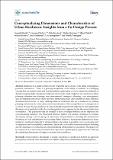| dc.contributor.author | Sharifi, Ayyoob | |
| dc.contributor.author | Chelleri, Lorenzo | |
| dc.contributor.author | Fox-Lent, Cate | |
| dc.contributor.author | Grafakos, Stelios | |
| dc.contributor.author | Olazabal, Marta | |
| dc.contributor.author | Moloney, Susie | |
| dc.contributor.author | Yumagulova, Lily | |
| dc.contributor.author | Yamagata, Yoshiki | |
| dc.contributor.author | Pathak, Minal M | |
| dc.date.accessioned | 2018-11-29T14:47:16Z | |
| dc.date.available | 2018-11-29T14:47:16Z | |
| dc.date.issued | 2017-06 | |
| dc.identifier.issn | 2071-1050 | |
| dc.identifier.uri | http://hdl.handle.net/1721.1/119361 | |
| dc.description.abstract | Resilience is a multi-faceted concept frequently used across a wide range of disciplines, practices, and sectors. There is a growing recognition of the utility of resilience as a bridging concept that can facilitate inter-and transdisciplinary approaches to tackle complexities inherent in decision making under conditions of risk and uncertainty. Such conditions are common in urban planning, infrastructure planning, asset management, emergency planning, crisis management, and development processes where systemic interdependencies and interests at stake influence decisions and outcomes. A major challenge that can undermine the use of resilience for guiding planning activities is the value-laden and contested nature of the concept that can be interpreted in a variety of ways. Because resilience is context-specific and generally depends on local aspirations, this issue can be partially tackled by adopting participatory approaches for the conceptualization of resilience. This paper provides an example of how co-design methods can be employed for conceptualizing resilience. The Structured Interview Matrix was used as a technique to facilitate discussions among a diverse group of researchers and practitioners attending the International Workshop on Tools and Indicators for Assessing Urban Resilience. Participants deliberated on issues related to constituent elements of urban resilience, including its position vis-s-à-vis concepts such as adaptation and sustainability, institutional factors that can enable/constrain resilience building, and the challenges of conducting and operationalizing urban resilience assessment. This paper can be considered as an initial step towards further exploration of participatory approaches for clarifying
the underlying dimensions of complex concepts such as resilience.
Keywords: urban resilience; knowledge co-design; knowledge co-production; bottom-up approach; participatory methods; Structured Interview Matrix; adaptation; sustainability; transdisciplinary | en_US |
| dc.publisher | Multidisciplinary Digital Publishing Institute | en_US |
| dc.relation.isversionof | http://dx.doi.org/10.3390/su9061032 | en_US |
| dc.rights | Creative Commons Attribution | en_US |
| dc.source | Multidisciplinary Digital Publishing Institute | en_US |
| dc.title | Conceptualizing Dimensions and Characteristics of Urban Resilience: Insights from a Co-Design Process | en_US |
| dc.type | Article | en_US |
| dc.identifier.citation | Sharifi, Ayyoob, et al. “Conceptualizing Dimensions and Characteristics of Urban Resilience: Insights from a Co-Design Process.” Sustainability, vol. 9, no. 6, June 2017, p. 1032. | en_US |
| dc.contributor.department | Massachusetts Institute of Technology. Department of Urban Studies and Planning | en_US |
| dc.contributor.mitauthor | Pathak, Minal M | |
| dc.relation.journal | Sustainability | en_US |
| dc.eprint.version | Final published version | en_US |
| dc.type.uri | http://purl.org/eprint/type/JournalArticle | en_US |
| eprint.status | http://purl.org/eprint/status/PeerReviewed | en_US |
| dc.date.updated | 2018-11-22T14:23:32Z | |
| dspace.orderedauthors | Sharifi, Ayyoob; Chelleri, Lorenzo; Fox-Lent, Cate; Grafakos, Stelios; Pathak, Minal; Olazabal, Marta; Moloney, Susie; Yumagulova, Lily; Yamagata, Yoshiki | en_US |
| dspace.embargo.terms | N | en_US |
| mit.license | PUBLISHER_CC | en_US |
